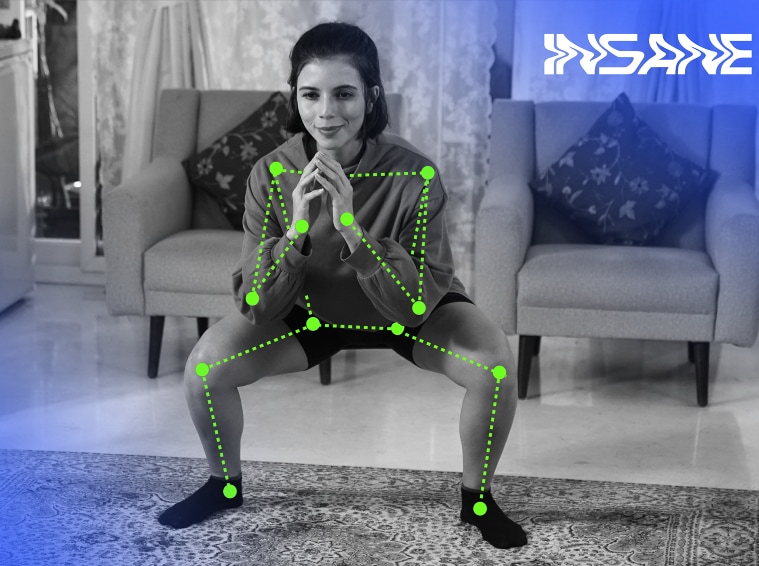Hybrid AI-powered computer vision combines physics and big data
SOURCE: HTTPS://WWW.SCIENCEDAILY.COM/
AUG 14, 2023
How an Indian startup is using smartphone’s front camera to make fitness fun
SOURCE: INDIANEXPRESS.COM
OCT 24, 2022

Two years ago, when Anurag Mundhada and Jayesh Hannurkar, graduates from IIT-Bombay, were struggling with weight issues during the first wave of the coronavirus pandemic, they thought of bringing their expertise in sensors and computer vision to create an interactive home workout platform.
“The biggest problem statement from a consumer point of view that we are working on to solve is motivation,” Mundhada explained the idea behind their Insane AI app. “Super fit models and trainers can sometimes really turn off beginners but if you make the initial onboarding smooth and frictionless as possible, fitness can be fun and is for everyone,” he said.
Insane AI, which is currently in beta for well over a year and nears official launch soon, is different from other fitness apps, claim the founders. Unlike Apple Fitness Plus or Nike Training Club, Insane AI uses your smartphone’s front camera to track your motion during a workout, they said.
“The camera tracks the body and divides it into 21 points: your shoulders, elbows, ankles, and knees. Once the tracking of points is done in real-time, we run a video AI layer on top of that which analyses the motion and clarifies which exercise is being done, counts the reps, and then the system gives a score of how intense the exercise is,” Mundhada told indianexpress.com during a video call.
Anurag Mundhada (left) and Jayesh Hannurkar (right) co-founded Insane AI in 2020.
“If you are doing a squat and your hips are below your knees, you get a score of one and if you are just doing very shallow reps, you will not get the same amount of score,” he added. Mundhada claimed its AI-powered workout tracking technology is 98 per cent accurate based on the company’s internal test data.
The intention to use a smartphone as an integral part of your fitness journey and create a new user experience around phone cameras comes from Mundhada and Jayesh’s previous experience in camera sensing technologies. Jayesh was with Sony Japan before co-founding Insane AI and worked on LiDAR sensors, a technology that adds depth scanning for better photos and AR in smartphones and is predominantly found in Apple’s high-end iPhones and iPad Pros since 2020. Mundhada, on the other hand, worked with a Bengaluru-based Axogyan AI where he did a project with Mercedes Benz for human sensing for autonomous vehicles.
Mundhada said he and his team were fascinated by Nintendo Wii and Microsoft Kinect and wanted to bring the ability to track body motion using a phone camera. Although smartphones over the years have got better hardware, depth sensors still are limited to a handful of expensive phones. “Using AI we enabled the normal RGB camera to track real-time workout tracking which is present on all phones to do what Nintendo Wii or Xbox Kinect can do,” he said when asked how a smartphone camera can track body motion with no additional sensors.

The Insane AI app uses your smartphone’s front-facing camera to track your body motion.
To test whether the smartphone camera really tracks body motion and whether an app can be created around home workouts, Mundhada developed Pushup dojo which went live in the early days of the pandemic. The app was used as a proof of concept to demonstrate that technology and workout tracking using a phone camera could be possible. It was a basic workout app that garnered 2000 users, mostly friends and immediate family of the co-founders. That gave Mundhada some confidence to rework the algorithms and user interface and perfect the body motion tracking technology to create the Insane AI app in early 2021. This time, the team worked with fitness trainers to create the app and intended a wide user base.
Mundhada calls Insane AI a home workout app with a “highly gamified experience.” The app, which can be downloaded from the Google Play Store and Apple App Store, currently requires people to sign-up for the waitlist, and beginning the last week of October, Insane AI will become available to those who are currently on the waitlist.
To use the app, one has to first set up a cartoon(y) avatar which will be your virtual identity on the workout platform. You can just place the phone in front of you at a distance, start exercising, and the camera then starts tracking your body motion during the workout. Every workout or exercise users do will be counted and they will get rewarded through coins which can be redeemed in the form of digital collectibles and coupons for which the startup has tied up with a few partners. Users can also challenge their friends both in real-time as well as turn-based fitness battles. The Insane AI app works on any smartphone that has been launched in 2016 and after. In the coming days, users will see a brand-new interface and a host of features including a lot more workouts and exercises.

Mundhada calls Insane AI a home workout app with a “highly gamified experience.”
The AI-powered workout technology model developed by Mundhada and his team not just tracks body points but also tracks users’ fitness levels across five different dimensions such as strength, cardio, upper body, and lower body. Mundhada said they have taken a lot of input from fitness experts to develop the workout plans and decide on different fitness levels, while the company’s in-house data science team has worked on creating a fitness model which can be customised and personalised as per a user. The insane AI app offers 35 different exercises and 150 workouts, out of which 4 workouts are free, to begin with.
According to Mundhada, Insane AI seems to be widely used at 7:30 am and another peak comes in the evening, around 6 pm. On average, users spend nine minutes on the app, up from 5 minutes in the early days of Insane AI. However, power users spend almost an hour on the platform.
“Insane AI is not meant to replace a personal trainer completely,” Mundhada said, adding the app is “designed to have an easy pathway to learning fitness and getting more advanced.” “For cases such as extreme obesity, it is always advisable to have a human in the loop and that’s not just for learning but also for the prevention of injuries someone who can help you spot you when you’re lifting weights.” Mundhada is clear that Insane AI aims to provide a rewarding and fun experience and complement your journey along the way.
The home workout app comes with a promise of not collecting users’ pictures and videos but only collecting anonymised data of motion itself to improve the AI engine which does the motion tracking.
For monetisation, Mundhada says they are going for a freemium model that will let users experience the app for free, with certain features such as advanced challenges and redeeming rewards requiring a subscription. Right now, those who sign-up for the app will get up to six months of free subscription. Mundhada and the team are yet to figure out what would be the cost of a subscription.
Last year, the start-up raised $900,000 in seed funding. The round was led by early-stage venture capital fund pi Ventures, Anupam Mittal, Sameer Pitalwalla, and other angels in sports, fitness, and tech. In the long run, Mundhada wants to turn Insane AI into a fitness metaverse and work on building a foundation for an immersive world that has already been started.
LATEST NEWS
Augmented Reality
Hi-tech smart glasses connecting rural and remote aged care residents to clinicians
NOV 20, 2023
WHAT'S TRENDING


Data Science
5 Imaginative Data Science Projects That Can Make Your Portfolio Stand Out
OCT 05, 2022

SOURCE: HTTPS://WWW.SCIENCEDAILY.COM/
AUG 14, 2023